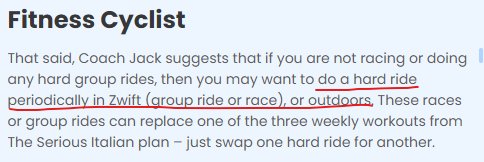This is not about syncing to Zwift, but more about using CJ plan/structured training in parallel with doing free rides on Zwift or any other platform or even outside - for that matter.
Also - I am not training for any competition, just to stay fit. I am getting closer to my 6x decade on this planet, picked up biking several years ago and go to about 40-50 percentile in capabilities for may age group… Maybe I can get a bit more - and that is why I need some training structure.
For quite sometime already I am, looking for a tool, which would let me do structured training, but then allow me to do my own riding 1-2 days a week and keep workout plan adjusted to accommodate the load from free rides - if more/less needed of particular workout types… So far I couldn’t find anything. I haven’t tried TrainerRoad (and don’t really want to), Xert can do this in theory, but it is not that good in practice (but their new “magic buckets” might be a step in right direction).
I would love TrainerDay to improve CJ to work in load incurred in free rides, but there is another way - maybe some workouts can be just replaced with specific Zwift rides - for example, I can do long endurance ride with an appropriate robopacer or do VO2max while climbing AdZ.
So I was very interested when I saw this while checking CJ recently:

My excitement was short lived though ![]()
- The frame to read CJ plan descriptions is too small - hard to read while scrolling - there is a lot of useful information
- Would be really great if all these descriptions can be published as a web page/pdf/epub - I had to go extra mile, copy them all together and create the doc for myself…
- This specific paragraph is out of place - I believe it belongs to the
The Serious Italiansection - and if all of these would have been published together, such error can be quickly recognized - @Alex you may want to correct this… - And the last one - there is no guidance on how to augment
The Serious Italianplan with out of plan riding - it would be great if some guidance can be published on this.
I guess, my question is - are there any guidelines available for the last item above?
Would it be a good idea to map different workout types to different type of free rides in a table, then ride and keep a tab on the load/rest/recovery via intervals.icu (which I love as well and wish it would get some training recommendation engine ![]() ).
).
Any advice would be appreciated!